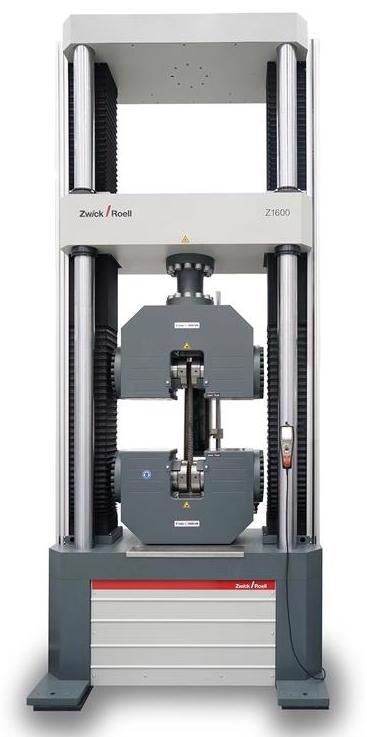Reinforcing steel and ribbed reinforcement bars (rebars) are essential to civil engineering, forming a category of key structural materials which, in the case of concrete-reinforcing steel, are heavily regulated. ZwickRoell provides testing solutions to undertake tensile tests of up to 5,000 kN on concrete-reinforcing steel.
Concrete has substantial compressive strength but lower tensile strength, and consequently it is fortified using embedded steel. Reinforcing steels are principally manufactured in diameters between approx. 10 mm and approx. 50 mm. The narrower diameters are subsequently further processed into lattices or mats prior to being embedded in concrete on site.

Tensile Testing Machine from ZwickRoell
Testing such ribbed steels presents special challenges because, other than incising to length, no additional mechanical specimen preparation occurs. ZwickRoell has produced a tensile testing machine, equipped with a non-contact extensometer, for executing tensile tests on concrete-reinforcing steel (DIN 488-2, ISO 15630, ISO 6892-1). The testing machine is fitted with hydraulic grips that guarantee diverse specimens are securely gripped.
One of the notable advantages of the machine is that specimens embodying diameters of between 10 and 50 mm can be clasped with a singular pair of grip inserts, thus removing the necessity of changing jaws for each specimen diameter. This enhances specimen throughput, while also reducing investment costs.
videoXtens Extensometer
The center of the tensile testing machine is the videoXtens extensometer, which contains six integrated cameras, allowing the system to measure the strain up to break, without making contact. As a result of automatic rib detection, separate specimen marking is no longer required. Six cameras span a measurement range of 680 mm, with the starting gauge length L0 at 50 to 500 mm.
The videoXtens is categorized in accuracy class 1 (to ISO 9513) and possesses a resolution of 0.6 µm. As the videoXtens allows the strain to be calculated after specimen break, an instantaneous assessment of the strain at break (A) is supplied, eradicating the necessity of marking and manually measuring the specimen following the test.
The optional Test Re-Run module in testXpert III permits retrospective re-measurement of strain by examining an image series observed during a test, using an alternative starting gauge-length (as long as multiple markings are present). This can be especially desirable if, for example, the specimen breaks outside of the initially calibrated measurement range.

Strain Distribution Method
By utilizing the Strain distribution method, this can even be executed during live test straining implementation, automatically relocating the starting gauge length to the area with the maximum strain. This means that specimen break always happens within the gauge length. Consequently, the amount of failed attempts can be significantly minimized, which will help to save both time and money (specimen material).
Tensile Tests on Concrete-Reinforcing Steel
Tensile tests on concrete-reinforcing steel (DIN 488-2, ISO 15630, ISO 6892-1) utilizing a ZwickRoell tensile testing machine with the non-contact extensometer videoXtens.

This information has been sourced, reviewed and adapted from materials provided by ZwickRoell GmbH Co. KG.
For more information on this source, please visit ZwickRoell GmbH Co. KG